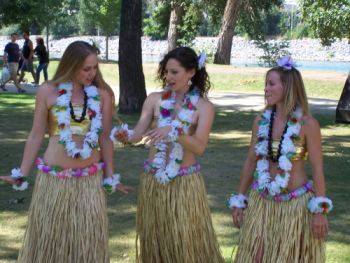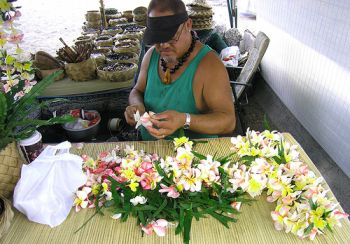Lei
Lei in Hawaiian language means a wreath or garland. There is also a popular meaning which defines lei as flower wreath put, as a sign of affection, around someone's neck at the arrival or departure. Lei is presented at wedding, funerals, graduations, birthdays etc. On the 1st of May people of Hawaii celebrate the “Lei Day.” It has been celebrated since 1927. It was initiated by the poet Don Blanding (1894-1927).
 Three women wearing lei
Three women wearing lei
All kind of materials are used for making a lei – flowers (plumerias, ʻōhiʻa lehua, orchids, pikake) and different leaves (maine, ferns, li). Some lei even include objects like for example shells, bones, paper etc. There are two main types of lei – Ti Leaf Lei and Maile Lei. Lei is part of many Hawaiian traditions. Since World War 2 people have giving lei with a kiss. According to local tradition lei should be presented with a slight bow and raising it above the heart. After that person who accepts the lei takes it in his/her hands and puts it around the neck.
 Lei making in Hawaii
Lei making in Hawaii
Lei can be opened or closed. Pregnant woman or the one with a baby should always get only opened lei. As a symbol of love, lei should never be put into trash. According to the Hawaiian belief old lei should be returned to the place where it was made. If this is not possible it should be left on a tree, burned or buried in the soil. Lei or something very similar exist all across the Polynesia - “ula” (Samoa), “hei” (Tahiti), “ei” (the Cook Islands), “kahoa” (Tonga).